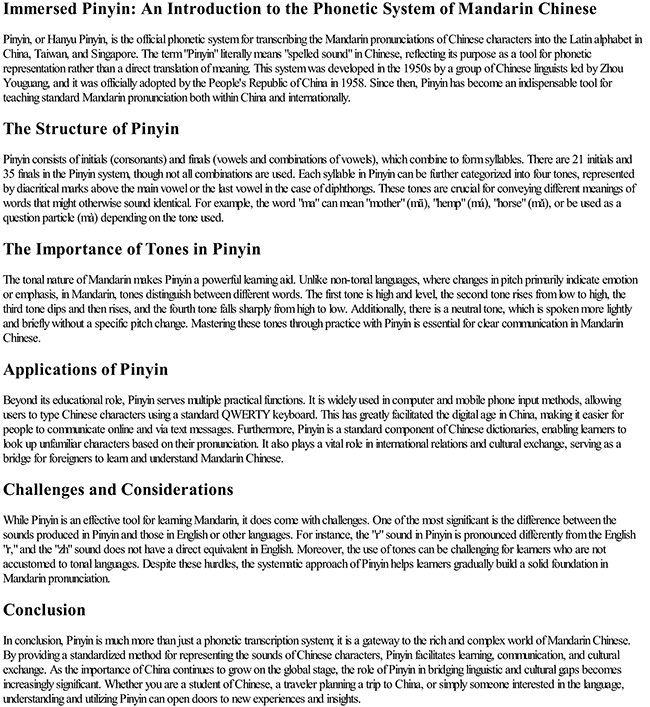Immersed Pinyin: An Introduction to the Phonetic System of Mandarin Chinese
Pinyin, or Hanyu Pinyin, is the official phonetic system for transcribing the Mandarin pronunciations of Chinese characters into the Latin alphabet in China, Taiwan, and Singapore. The term "Pinyin" literally means "spelled sound" in Chinese, reflecting its purpose as a tool for phonetic representation rather than a direct translation of meaning. This system was developed in the 1950s by a group of Chinese linguists led by Zhou Youguang, and it was officially adopted by the People's Republic of China in 1958. Since then, Pinyin has become an indispensable tool for teaching standard Mandarin pronunciation both within China and internationally.
The Structure of Pinyin
Pinyin consists of initials (consonants) and finals (vowels and combinations of vowels), which combine to form syllables. There are 21 initials and 35 finals in the Pinyin system, though not all combinations are used. Each syllable in Pinyin can be further categorized into four tones, represented by diacritical marks above the main vowel or the last vowel in the case of diphthongs. These tones are crucial for conveying different meanings of words that might otherwise sound identical. For example, the word "ma" can mean "mother" (mā), "hemp" (má), "horse" (mǎ), or be used as a question particle (mà) depending on the tone used.
The Importance of Tones in Pinyin
The tonal nature of Mandarin makes Pinyin a powerful learning aid. Unlike non-tonal languages, where changes in pitch primarily indicate emotion or emphasis, in Mandarin, tones distinguish between different words. The first tone is high and level, the second tone rises from low to high, the third tone dips and then rises, and the fourth tone falls sharply from high to low. Additionally, there is a neutral tone, which is spoken more lightly and briefly without a specific pitch change. Mastering these tones through practice with Pinyin is essential for clear communication in Mandarin Chinese.
Applications of Pinyin
Beyond its educational role, Pinyin serves multiple practical functions. It is widely used in computer and mobile phone input methods, allowing users to type Chinese characters using a standard QWERTY keyboard. This has greatly facilitated the digital age in China, making it easier for people to communicate online and via text messages. Furthermore, Pinyin is a standard component of Chinese dictionaries, enabling learners to look up unfamiliar characters based on their pronunciation. It also plays a vital role in international relations and cultural exchange, serving as a bridge for foreigners to learn and understand Mandarin Chinese.
Challenges and Considerations
While Pinyin is an effective tool for learning Mandarin, it does come with challenges. One of the most significant is the difference between the sounds produced in Pinyin and those in English or other languages. For instance, the "r" sound in Pinyin is pronounced differently from the English "r," and the "zh" sound does not have a direct equivalent in English. Moreover, the use of tones can be challenging for learners who are not accustomed to tonal languages. Despite these hurdles, the systematic approach of Pinyin helps learners gradually build a solid foundation in Mandarin pronunciation.
Conclusion
In conclusion, Pinyin is much more than just a phonetic transcription system; it is a gateway to the rich and complex world of Mandarin Chinese. By providing a standardized method for representing the sounds of Chinese characters, Pinyin facilitates learning, communication, and cultural exchange. As the importance of China continues to grow on the global stage, the role of Pinyin in bridging linguistic and cultural gaps becomes increasingly significant. Whether you are a student of Chinese, a traveler planning a trip to China, or simply someone interested in the language, understanding and utilizing Pinyin can open doors to new experiences and insights.

点击下载 浸泡的拼音Word版本可打印
点击下载 浸泡的拼音pdf版本可打印